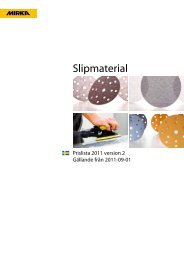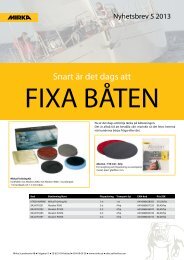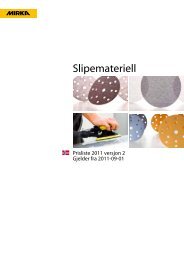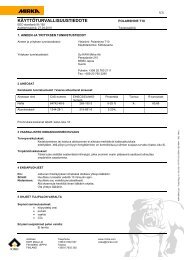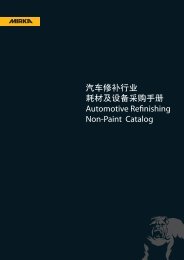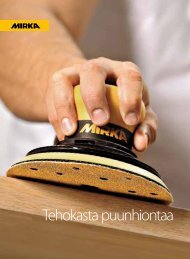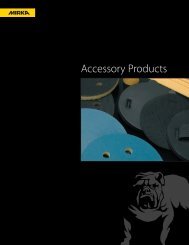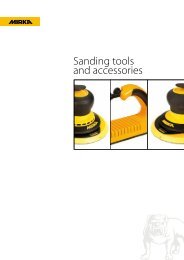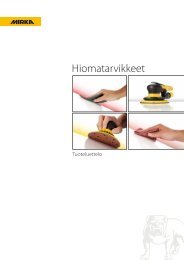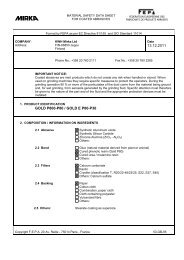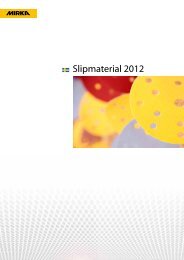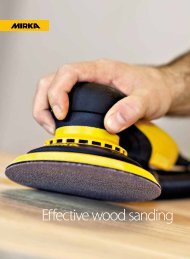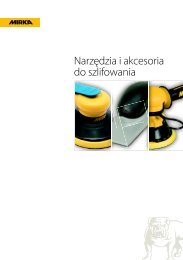ROS 125 150 mm.pdfTélécharger - Mirka
ROS 125 150 mm.pdfTélécharger - Mirka
ROS 125 150 mm.pdfTélécharger - Mirka
You also want an ePaper? Increase the reach of your titles
YUMPU automatically turns print PDFs into web optimized ePapers that Google loves.
that the original Filter was in before removal. With a small<br />
diameter screwdriver or flat-ended rod, press the (14) Filter<br />
into the bore until it is flat in the bottom of the bore. Place the<br />
(15) Valve into the bore so it is oriented correctly, then press<br />
the (16) Retainer into the bore until it is flush with the bottom<br />
of the Bearing bore.<br />
4. Apply a pin head size drop of #271 Loctite® or equivalent to<br />
the outside diameter of each of the bearings on the spindle<br />
assembly. Spread the drop of bearing locker around the<br />
bearing until distributed evenly. CAUTION: Only a very<br />
small amount of bearing locker is needed to prevent rotation<br />
of the bearing OD. Any excess will make future removal<br />
difficult. Place the (22) Spindle Assembly into the bore of<br />
the (13) Shaft Balancer and secure with the Retaining Ring.<br />
CAUTION: Make sure that the Retaining Ring is completely<br />
snapped into the groove in the Balancer Shaft. Allow the<br />
adhesive to cure.<br />
Motor Assembly:<br />
1. Place the (61) Dust Shield onto the shaft of the (13) Shaft<br />
Balancer.<br />
2. Use the larger end of the (MPA0494) T-13 Bearing Press<br />
Sleeve to press the (10) front Bearing (with 2 Shields) onto<br />
the shaft of the (13) Shaft Balancer.<br />
3. Slide the (9) Front Endplate with the bearing pocket facing<br />
down onto the Motor Shaft. Gently press the (9) Front<br />
Endplate onto the (10) Bearing using the larger end of the<br />
T-13 Bearing Press Sleeve until the Front Bearing is seated<br />
in the bearing pocket of the (9) Front Endplate. CAUTION:<br />
Only press just enough to seat the bearing into the pocket.<br />
Over-pressing can damage the bearing.<br />
4. Place the (8) Key into the groove on the (13) Shaft Balancer.<br />
Place the (6) Rotor on the (13) Shaft Balancer, making sure<br />
that it is a tight slip fit.<br />
5. Oil the five (7) Vanes with a quality pneumatic tool oil and<br />
place them in the slots of the (6) Rotor. Place the (4) Cylinder<br />
Assembly over the (6) Rotor with the short end of the Spring<br />
Pin engaging the blind hole in the (9) Front Endplate.<br />
6. Press fit the (2) rear Bearing (2 shields) into the (3) Rear<br />
Endplate with the () T-1B Bearing Press Tool. Make sure the<br />
T 1B Press Tool is centered on the O.D. of the outer race.<br />
Lightly press fit the (3) Rear Endplate and Bearing Assembly<br />
over the (13) Shaft Balancer using the small end of the T-13<br />
Bearing Press Sleeve. The sleeve should press only the inner<br />
race of the bearing. IMPORTANT: The Rear Endplate and<br />
Bearing Assembly is pressed correctly when the Cylinder is<br />
squeezed just enough between the Endplates to stop it from<br />
moving freely under its own weight when the shaft is held<br />
horizontal, but be able to slide between the Endplates with<br />
a very light force. If the assembly is pressed to tightly the<br />
motor will not run freely. If the pressed assembly is to loose,<br />
the motor will not turn freely after assembly in the Housing.<br />
Secure the assembly by placing the (1) Retaining Ring in the<br />
groove of the (13) Shaft Balancer. CAUTION: The Retaining<br />
Ring must be placed so that the middle and two ends of the<br />
hoop touch the Bearing first. Both raised center portions must<br />
be securely “snapped” into the groove in the Shaft Balancer<br />
by pushing on the curved portions with a small screwdriver.<br />
7. Lightly grease the (5) O-Ring and place in the air inlet of the<br />
(4) Cylinder Assembly.<br />
8. Lightly grease or oil the inside diameter of the (27) Housing,<br />
line up the Spring Pin with the marking on the (27) Housing<br />
and slide the Motor Assembly into the Housing. Make sure<br />
the Spring Pin engages the pocket in Housing.<br />
9. Carefully screw the (12) Lock Ring into the (27) Housing<br />
with the (MPA0025) T-6 Motor Lock Ring Wrench/Spindle<br />
Puller Tool. Torque to 6.77 Nm (60 in/lbs). NOTE: A simple<br />
technique to assure first thread engagement is to turn the<br />
lock ring counter clockwise with the T-6 Motor Lock Ring<br />
Wrench/Spindle Puller while applying light pressure. You will<br />
hear and feel a click when the lead thread of the lock ring<br />
drops into the lead thread of the housing.<br />
10. Spin on a new (36) Pad and hand tighten it using a 24 <strong>mm</strong><br />
Pad Wrench.<br />
Testing:<br />
Place 3 drops of quality pneumatic air tool oil directly into the motor<br />
inlet and connect it to a 6.2 bar (90 psig) air supply. A 12,000<br />
RPM tool should run between 11,500 to 12,500 RPM when the<br />
air pressure is 6.2 bar (90 psig) at the inlet of the tool while the<br />
tool is running at free speed. This free speed will be about 500<br />
RPM to 1,000 RPM less when a Vacuum or Hook Face Pad is<br />
used because of wind resistance. This will not affect performance<br />
when sanding.<br />
Loctite® is a registered trademark of the Loctite Corp.<br />
DOC A0348 Rev 05/13/11<br />
10




